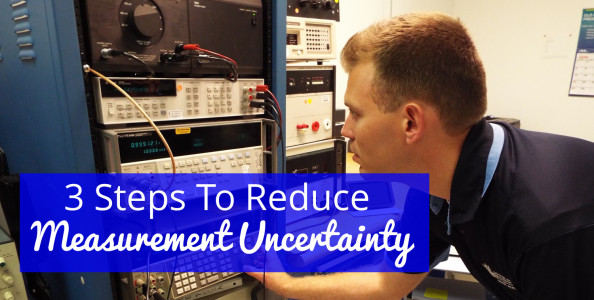Reducing measurement uncertainty has become a goal for many laboratories seeking to improve quality. Whether it is enhance their reputation or make themselves more competitive in the marketplace, many want to improve their measurement capabilities. To help organizations accomplish this goal, I have compiled a list of three highly-effective methods to reduce measurement uncertainty.
Test and Collect Data
“Look for combinations that yield less variability. These processes will typically yield less measurement uncertainty.“
When your goal is to reduce measurement uncertainty, my best recommendation is to experiment and collect lots and lots of data. What kind of data? Repeatability and reproducibility data.
Repeatability data allows you to analyze and observe the variability in your measurement processes under repeatable conditions. So, perform the same process over and over again, and analyze your data. The more measurements you repeat, the more confident you will become in the results.
Reproducibility data allows you to analyze and observe the variability of reproducing measurement results by changing common elements of your measurement process. This can be accomplished by altering things like environmental conditions, operators, equipment, days, time, etc. As you evaluate the results, look for combinations that yield less variability. These processes will typically yield less measurement uncertainty.
Now, it may sound like a lot of work; but, it is not. You will be surprised how much data you can collect by dedicating just 15 to 30 minutes of your day to experimentation. Afterward, you will know a lot more about your measurement processes and learn which combination of variables yield measurement results with less uncertainty.
Select a Better Calibration Laboratory
“Review a laboratory’s scope of accreditation before you select them as a service provider.“
One of the easiest ways to reduce measurement uncertainty is to decrease the traceable uncertainty associated with calibration results. This can be accomplished by selecting better laboratories or calibration service providers.
When a laboratory is able to provide you calibration results with less uncertainty, you will typically be able to reduce the uncertainty associated with your measurement processes. Why? Well, you can not report a statement of uncertainty that is less than the uncertainty received via calibration. Therefore, if you reduce the uncertainty received from your calibration service provider, you will be able to decrease your uncertainty estimates.
To accomplish this, review a laboratory’s scope of accreditation before you select them as a service provider. You can use the links in my article How To Find An ISO 17025 Accredited Laboratory to help you out. Check out the laboratory’s Calibration Measurement Capability (CMC) and see if it meets your goals. If you are unsure, contact the laboratory to discuss your requirements.
Remove Bias and Characterize
“Keep a list of Key Comparison Values … for standards and artifacts that will be used for critical or precision calibrations.“
Another way to reduce uncertainty is to remove measurement bias. Bias is the systematic error associated with calibration values of your standard or artifact. By removing bias, we reduce the uncertainty associated with our comparisons.
For example, imagine you are calibrating a precision multimeter at 10 volts using a Multi-Function Calibrator. Now, the 10.000000 VDC output from the calibrator is not really a perfect 10.000000 VDC. Most likely, it is 9.999997 VDC or something similar (hint: look at your calibration report). By comparing your results to the actual value, you are able to reduce your uncertainty.
My recommendation is to keep a list of ‘Key Comparison Values.’ These are the actual comparison values for key standards and artifacts that will be used for critical or precision calibrations. Using this list, you will never again have to pull a calibration report to find these values which saves time and increases productivity (and quality).
Conclusion
While there are plenty of ways to reduce measurement uncertainty, these 3 methods should get you started to on your journey to achieving your goals. If you have any additional tips, share them using the comment section below or emailing me at [email protected].
For great content and tips delivered to your inbox, subscribe to my blog.





One Comment